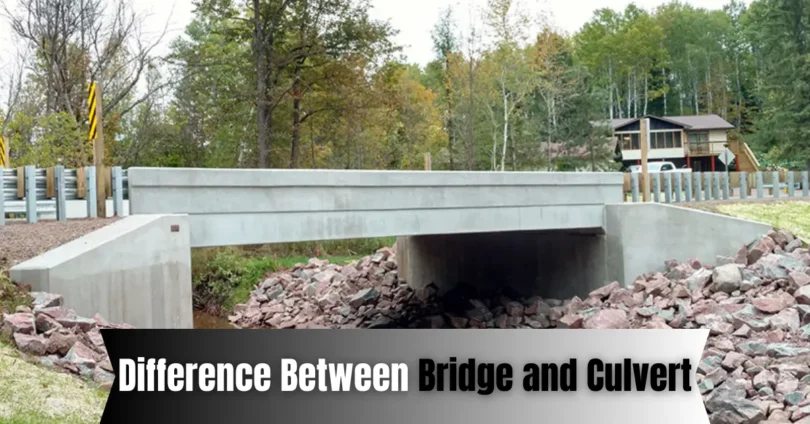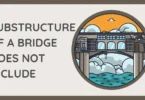When it comes to building infrastructure, understanding the difference between bridge and culvert is important. Both structures help us manage obstacles like rivers, streams, or valleys, but they serve different purposes and are designed in unique ways.
The difference between bridge and culvert lies in their size, function, and how they are built. In this article, we will explore these differences to help you understand when each structure is the best choice for a project.
What is a Bridge?
A bridge is a structure built to span over obstacles like rivers, valleys, or roads. Its main purpose is to allow vehicles, people, or trains to pass safely over these obstacles.
Definition and Primary Purpose
- A bridge connects two areas separated by an obstacle.
- Its primary purpose is to provide a safe passage for traffic and pedestrians.
Common Uses and Examples
- Road Bridges: Allow vehicles to pass over rivers or valleys, such as the Golden Gate Bridge in San Francisco.
- Railroad Bridges: Help trains cross over natural barriers, like the Forth Railway Bridge in Scotland.
- Pedestrian Bridges: Built for people to walk across obstacles, such as the Brooklyn Bridge in New York.
Types of Bridges
- Suspension Bridges
- Large, strong bridges with cables suspended between towers.
- Example: Golden Gate Bridge.
- Beam Bridges
- The simplest type of bridge, supported by beams on each end.
- Example: London Bridge.
- Arch Bridges
- Have a curved structure that distributes weight evenly.
- Example: Ponte Vecchio in Italy.
What is a Culvert?
A culvert is a tunnel-like structure used to allow water to flow under a road, railway, or other obstacles. It helps manage drainage and prevent flooding.
Definition and Primary Purpose
- A culvert is designed to channel water beneath roads or railways.
- Its primary purpose is to maintain natural water flow and prevent road damage.
Common Uses and Examples
- Stormwater Drainage: Used to direct rainwater away from roads, such as culverts under highways.
- Stream Diversion: Helps redirect small streams or creeks under roads, like the culverts in rural areas.
Types of Culverts
- Pipe Culverts
- Cylindrical pipes used to direct water flow under roads.
- Example: Used in many small streams and rural roads.
- Box Culverts
- Rectangular structures often used for larger water flows.
- Example: Found in urban settings where water volume is higher.
- Arch Culverts
- Arched design allows for more space and better water flow.
- Example: Common in areas with more uneven terrain or high water flow.
Key Differences Between Bridge and Culvert
Understanding the key differences between a bridge and a culvert can help you choose the right structure for your project.
Size and Structure: Size of Bridges vs. Culverts
- Bridges are much larger and designed to carry traffic, whether it’s vehicles, trains, or pedestrians.
- Culverts are smaller and mainly designed for water flow, not for traffic.
Purpose and Function: When to Use a Bridge vs. a Culvert
- Bridges are used when the obstacle (like a river or valley) is too wide or deep for a simple structure.
- Culverts are ideal for narrow water channels or where the road doesn’t need to be elevated.
Design and Construction: Materials and Design Differences
- Bridges require strong materials like steel, concrete, or wood, and they often have supports or piers.
- Culverts are usually made from concrete, steel, or plastic pipes and are easier to install.
Cost and Maintenance: Budget Considerations for Both
- Bridges are more expensive to build and maintain due to their size, materials, and complexity.
- Culverts are generally cheaper to build and maintain because of their simpler design and smaller size.
When to Use a Bridge vs. a Culvert
Choosing between a bridge and a culvert depends on the situation and the specific needs of your project.
Situations Where a Bridge is Necessary
- Wide or Deep Obstacles: When the obstacle, such as a river or valley, is too wide or deep for a culvert.
- Heavy Traffic: If the structure needs to support heavy traffic, including vehicles, trains, or pedestrians.
- Long Lifespan: When the project needs to last for many decades and handle a large volume of traffic.
- Flood-Prone Areas: If floodwaters are frequent and require a high structure to allow water to pass without damage.
Situations Where a Culvert is a Better Solution
- Narrow Waterways: When dealing with small streams or channels that don’t require a large structure.
- Low Traffic Volume: If the area doesn’t require heavy traffic or large vehicles to pass over the water.
- Cost-Effective Projects: When budget is limited and the main concern is managing water flow rather than supporting heavy loads.
- Quick Installation: If the project requires a simple solution that can be installed quickly without needing complex construction.
Real-Life Examples of Bridges and Culverts
To help understand how bridges and culverts are used in real-world infrastructure, here are some well-known examples:
Example 1: Famous Bridges
- Golden Gate Bridge (USA): One of the most famous suspension bridges in the world, connecting San Francisco to Marin County. It handles heavy traffic and provides a safe passage over the Golden Gate Strait.
- Tower Bridge (UK): A combined bascule and suspension bridge in London, designed to allow large ships to pass through while supporting heavy vehicular and pedestrian traffic.
- Sydney Harbour Bridge (Australia): Known as the “Coathanger,” this steel arch bridge connects Sydney’s central business district with the North Shore. It supports both vehicles and trains.
Example 2: Well-Known Culverts Used in Infrastructure
- Stormwater Culverts in New York: Culverts are used to manage stormwater under roads and highways in urban areas like New York City. These pipes help prevent flooding by directing water away from busy streets.
- Culverts in Rural Areas: Small culverts are commonly found in rural areas where streams or ditches flow under country roads. They help maintain water flow while keeping the road intact.
- Box Culverts on Highways: In many highway projects, box culverts are used to manage larger volumes of water under roads, especially in flood-prone areas.
Common FAQs on the Difference Between Bridge and Culvert
What’s the main difference between a bridge and a culvert?
A bridge is a large structure designed to allow traffic to pass over an obstacle, like a river or valley. A culvert is a smaller structure that lets water flow under a road or railway.
When should I use a bridge instead of a culvert?
You should use a bridge when the obstacle is wide, deep, or requires supporting heavy traffic. A culvert is better for smaller water flows or when the road doesn’t need to support heavy loads.
Are bridges more expensive than culverts?
Yes, bridges are typically more expensive due to their size, materials, and complexity. Culverts, being smaller and simpler, are usually cheaper to build and maintain.
Can a culvert handle large amounts of water?
Culverts can handle a lot of water, but they are best for smaller streams or drainage. For larger bodies of water, a bridge is often required.
What types of bridges and culverts are there?
Common bridge types include suspension, beam, and arch bridges. For culverts, you can find pipe, box, and arch types, depending on the size of the water flow and the area.
Conclusion
Both bridges and culverts are important structures, but they serve different purposes. Bridges are used to span over wide or deep obstacles and support heavy traffic, while culverts are smaller and focus on managing water flow under roads.
Understanding the difference between bridge and culvert helps in choosing the right structure for your project, depending on factors like size, cost, and purpose. Whether you’re dealing with a river or a stream, each one has its place in modern infrastructure.






